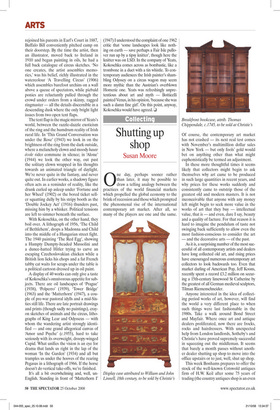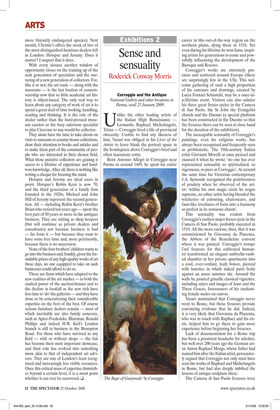Shutting up shop
Susan Moore
One day, perhaps sooner rather than later, it may be possible to draw a telling analogy between the practices of the world financial markets which propelled the global economy to the brink of recession and those which prompted the phenomenal rise of the international contemporary art market. After all, so many of the players are one and the same. Of course, the contemporary art market has not crashed — its next real test comes with November’s multimillion dollar sales in New York — but only fools’ gold would bet on anything other than what might euphemistically be termed an adjustment.
In these more thoughtful times it seems likely that collectors might begin to ask themselves why art came to be produced in such large quantities in recent years, and why prices for these works suddenly and consistently came to outstrip those of the greatest old and modern masters. It is not inconceivable that anyone with any money left might begin to seek more value in the works of art that they buy — intellectual value, that is — and even, dare I say, beauty and a quality of facture. For that reason it is hard to imagine the pendulum of taste not swinging back sufficiently to allow even the most fashion-conscious to consider the art — and the decorative arts — of the past.
As it is, a surprising number of the most successful of all contemporary artists and dealers have long collected old art, and rising prices have encouraged numerous contemporary art collectors to look backwards too. Even that market darling of American Pop, Jeff Koons, recently spent a record £3.2 million on securing a 15th-century limewood St Catherine by the greatest of all German medieval sculptors, Tilman Riemenschneider.
Anyone interested in the idea of collecting period works of art, however, will find the world a very different place to when such things were last fashionable in the 1980s. Take a walk around Bond Street and Mayfair. Where once art and antique dealers proliferated, now there are frocks, rocks and hairdressers. With unexpected help from London landlords, Sotheby’s and Christie’s have proved supremely successful in squeezing out the middleman. It seems that barely a month passes without another dealer shutting up shop to move into the office upstairs or to just, well, shut up shop.
This week Bonhams prepares to offer the stock of the well-known Cotswold antiques firm of H.W. Keil after some 75 years of trading (the country antiques shop is an even more blatantly endangered species). Next month, Christie’s offers the stock of two of the most distinguished furniture dealers left in London: Hotspur and Jeremy. Does it matter? I suspect that it does.
With every closure another window of opportunity closes on the training up of the next generation of specialists and the nurturing of a new generation of collectors. For, like it or not, the art trade — along with the museums — is the last bastion of connoisseurship now that so little academic art history is object-based. The only real way to learn about any category of work of art is to spend a great deal of time looking, handling, reading and thinking. It is the role of the dealer rather than the hard-pressed museum curator or the busy saleroom specialist to play Cicerone to any would-be collector.
They alone have the time to take clients on visits to museum or country-house collections, draw their attention to books and articles and to make them part of the community of people who are interested in their chosen field. What those putative collectors are gaining is access to a lifetime of experience and hardwon knowledge. After all, there is nothing like writing a cheque for focusing the mind.
Hotspur and Jeremy are ideal cases in point. Hotspur’s Robin Kern is now 70, and the third generation of a family firm founded in the 1920s; Michael and John Hill of Jeremy represent the second generation. All — including Robin Kern’s brother Brian who retired ten years ago — spent the best part of 50 years or more in the antiques business. They are exiting as shop keepers (but will continue as private dealers and consultants) not because business is bad — far from it — but because they want to have some free time and, more pertinently, because there is no succession.
None of the four brothers’ children wants to go into the business and, frankly, given the formidable prices of any high-quality works of art these days, no one equipped to take on such businesses could afford to do so.
These are firms which have adapted to the new realities of the art market — to both the exalted power of the auction-houses and to the decline in footfall as the new rich have less time to ‘do’ the galleries — and they have done so by concentrating their considerable expertise on the best of the best. Of course serious furniture dealers remain — most of which inevitably are also family concerns, such as Apter-Fredericks, Blairman, Ronald Phillips and indeed H.W. Keil’s London branch is still in business in the Brompton Road. For those who have survived in any field — with or without shops — the fair has become their most important showcase, and their role has evolved into something more akin to that of independent art advisors. They are one of London’s least recognised and increasingly less visible resources. Once this critical mass of expertise diminishes beyond a certain level, it is a moot point whether it can ever be recovered. ❑



















































































 Previous page
Previous page